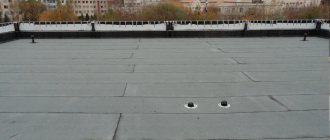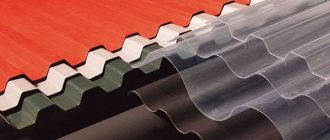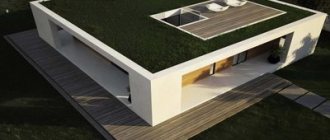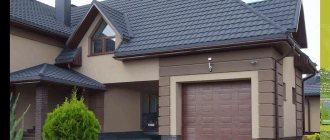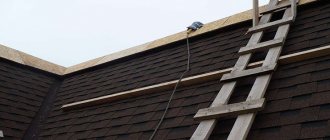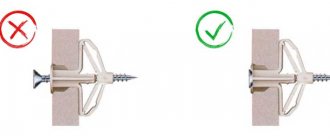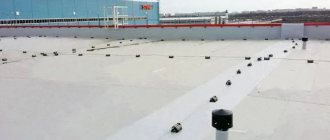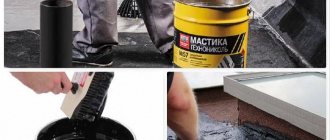Without proper organization of the drainage system, a flat roof will quickly require unscheduled repairs. Stagnation of rain and melt water on the surface will gradually erode the protective outer layer of the coating. As a result, the bare base will rapidly deteriorate from the sun's rays. And when freezing, water crystals can easily tear the material apart.
A properly constructed flat roof drain can prevent and prevent negative impacts. The rules and principles of the design of such an important drainage system should be carefully studied by the owner who cares about the effective and long service of his country property.
Why are gutters needed on a flat roof?
Water does not linger on roof slopes. However, if the building has a flat roof, heavy amounts of precipitation will accumulate on it during rain and snowfall. They can lead to the destruction of waterproofing, accumulation of dirt and even roof collapse. In addition, wind and rainwater can carry plant seeds onto the roof. As they sprout, they will further increase the load on the roofing surface.
To drain rainwater and melting snow from the roof, you need to install flat roof drains Source planninggroup.co
Gutter for a flat roof - types, design features and materials of manufacture
The water intake funnel for a flat roof is made of the following materials:
- Plastic
funnels made of polyvinyl chloride. - Metal
coated with zinc. This is the most common material for making funnels. It is inexpensive and does its job well. - Copper
. This material is not popular due to the high cost of the products.
Funnels are:
- Flat
. Such funnels are installed on flat roofs that are planned to be used frequently. If the roof is covered with asphalt or tiles, flat funnels are installed level with them. - Bell bells
. They have a protective filtration mesh. This mesh protects the drain from clogging. Its shape is a cap rising above the roof level.
Roof drainage funnels Source tofp.ru
Funnels can have a horizontal or vertical outlet. The difference between them is the location of the drain hole relative to the facade of the building. Funnels with horizontal outlet have a discharge pipeline that passes through the insulation layer. Such funnels are not very convenient, because when performing technical work to replace drainage pipes or funnels, it is necessary to open a significant area of the roof. If you lay a horizontal line above the frost line, ice jams may form in the pipes. Ice plugs in pipes can lead to leaks and water stagnation. The horizontal system is used on roofs that do not have an attic. On ordinary flat roofs, funnels with a vertical outlet are used.
A heating cable can be connected to the funnel. Thanks to this, the snow around will melt.
The ice inside and around the funnel will not freeze, and snow and water masses will not accumulate on the roof Source raindropgutterguard.com
You can find funnels of combined designs.
Main types of drainage system
The internal drain, its elements and structure, consists of various units, gratings and sockets.
Now companies can manufacture such systems to order, according to all the provided parameters and sizes that the customer will need. You just need to develop a project and coordinate it with engineers. Typical indoor gutters are made of alloy steel, aluminum, PVC. Of course, you can use plastic pipes, but they are not designed for large flows of water and will immediately begin to be damaged. But internal gutters made of steel pipes are much more stable and reliable; they can withstand any flow of water and will last a fairly long time. But they can make a lot of noise, because water gets in, sweeps and makes loud sounds.
Copper drains are considered one of the best drains, but they are quite expensive, but they have no equal in durability, they can even withstand the acid rain that occurs in industrial areas. Previously, cast iron drains were also often used, but they did not pay off, because they are quite difficult to install due to their heavy weight. Pipes for internal water drainage can have different cross-sections. But mostly a rectangular profile is used, because it is very easy to use and does not require special care.
Structure of a drainage funnel
A typical funnel consists of:
- pressure ring
, which fits tightly to the roof and ensures tightness; - grates
to prevent objects from entering the drainage system; - horizontal or vertical pipe
; - a water receiver
that transfers water flows into pipes; - seals
, strengthening the places where the pipe connects to the pipe; - fixing flanges
; - covers
on top of the product.
Regular funnel Source pinterest.com
Gutter for flat roofing - types and installation methods
Installation is divided by type of installation:
- External structures
that are mounted around the perimeter of the house. - Internal
, which are laid during construction inside the walls and pass into the sewer. The tightness of such systems cannot be neglected. The result of poor-quality work will be the rapid occurrence of corrosion processes.
In the case of a flat roof, installing an internal drainage funnel is the most preferable solution. Horizontal pipes are laid under waterproofing and insulation.
Drain pipes located vertically carry sediment from horizontal pipes into the storm drain. Source www.allseasonsroof.com
Drainage systems can be:
- gravity
, that is, with a slope: water flows under the influence of gravity; - vacuum
, without a slope: they work on the principle of a drain tank, for which they received a second name - “siphon”.
Varieties
A characteristic difference between internal and external drainage is the installation location, since installation is carried out inside the structure. On the one hand, this design provides some advantages, on the other hand, it is associated with difficulties, since each unit must be reliably sealed to prevent leaks. The number and diameter of the elements is determined by the calculation based on determining the roof area and the amount of precipitation. There are two types of internal drainage system:
- Gravity flow. The gravity-flow type of drain is the simplest option, the calculation and installation of which is carried out without much difficulty. The design includes the following elements: funnels, outlet pipes, risers. A gravity-flow system is ineffective; it will not cope with the influx of water to which the roof is exposed during heavy rains if the diameter or number of elements does not correspond to the parameters shown by the calculation. The advantage of this solution is its low price.
Differences between gravity and siphon drainage systems
- Siphon. A drain operating on the principle of a siphon differs from a gravity drain in greater productivity. The siphon drainage system is completely filled with sediment, due to which a water column is formed in it from the water intake funnel to the outlet into the sewer. If the liquid level in the riser drops, a vacuum zone is created in the funnel, sucking moisture from the roof surface. The cost of installing a drain of this type is higher due to the cost of special funnels with flow stabilizers. For the work to be effective, it is necessary to perform calculations and also select high-quality material. The advantage of this design is that with the rapid movement of water, each drainage unit is self-cleaning, regardless of what material was used.
Water inlet funnel with flow stabilizer for siphon drainage
Flat roof drains: installation and heating
Funnels are installed to ensure that water flows into drains under the influence of gravity. They should be located in the lowest areas of the roof. To ensure water drainage, a roof slope of 2% is sufficient. If such a slope is absent, then it is created artificially - for the entire roof or a so-called “slope” is made - using expanded clay, insulation slabs or concrete.
Functional purpose of flat roof slopes Source beton-stroyka.ru
The roof surface is divided into equal areas of regular geometric shapes. The lower part of the product is mounted into the base of the roof to connect the funnel to the drainpipe. After the waterproofing and insulation have been laid, the lower and upper parts of the funnel are connected using an o-ring seal. A plastic funnel apron should be located between the layers of roofing felt. It is secured with an additional bitumen apron. From above, all these layers are covered with mastic or again with bitumen. A protective grill is installed.
They check the quality of the work done by throwing out a bucket of water at a distance of 2 meters from the funnel.
The speed and completeness of water discharge into the funnel determines how effective the slope is and whether the installed structure is airtight Source amarco.co
Calculation of drainage funnels on a flat roof
At least 2 funnels should be installed on the roof of the house to provide the necessary protection in case of unforeseen situations such as severe weather or blockages in the pipes. There should be one funnel for every 150 or 200 square meters of roof. Funnels are installed at a distance of 25 meters from each other if the length of the house itself exceeds 25 meters. The minimum distance from funnel to funnel is 50 centimeters. The funnel must not be installed closer than 1 meter to the edge of the roof.
If the building is divided into sections, each of them must be equipped with its own storm drainage funnel on the roof.
If there are parapets or expansion joints on the roof, each sector separated by them should have two funnels Source pxhere.com
See also: Catalog of popular plots in the Moscow region for the construction of a country house
Principles for selecting and installing a roof drain
When installing roof drains for flat roofs, you need to keep a few simple rules in mind. Without compliance with them, the efficiency of drainage structures will drop sharply:
- Metal funnels
are installed on roofs made of metal profiles or seams . - For roofs made of bitumen or on polymer coatings, you should choose polymer funnels
. - The connection between the funnel and the roof must be completely sealed
. To do this, you can glue an additional waterproofing layer, extending it directly on the sides of the funnel. If there are several layers of waterproofing on the roof, the funnel is installed between them. - The funnel must have a removable lid
and protection from dirt so that the latter does not fall into the drain. In addition, the protection system will help avoid clogging with leaves, branches, sand and other types of street debris. - It is necessary to provide heating
to the funnels so that the water in them does not freeze.
Installing a roof drain Source flatroofdoc.com
Pitched roof
For pitched roofs of low-rise buildings, an external drainage system is installed along the eaves of the roof. This is a system of horizontal gutters laid with a slight slope (3 - 3.5°) to the water intake funnels. And the funnels serve as connection points with a vertical drainpipe, which ends in a corner drain above the storm drain inlet.
To organize the horizontal and vertical parts of the drainage system, additional elements, docking units, and fastenings to the facade and roof sheathing are provided. Read more in the article: installation of drainage from a pitched roof.
All manufacturers offer several standard sizes of gutters and pipes (from two to five), which, depending on the size and design features of the roof, allow you to optimize the system for drainage performance. If you do not take into account the fastening elements, the main parts of the system are made of either plastic or metal.
Metal drain
This category is dominated by systems made of cold-rolled hot-dip galvanized sheet steel with a thickness of 0.5 - 0.7 mm. The multilayer protective coating is made using the same technology as that of corrugated sheets or metal tiles, and has the same palette as base colors. Therefore, from a decorative point of view, steel gutters are compatible with these roofing materials.
In addition to steel, drainage systems are made from the following non-ferrous metals:
Aluminum. The advantages include light weight and ease of installation. One of the most famous domestic manufacturers, the Linkor company, offers ready-made systems with powder coating of parts in several basic colors or makes them to order in any shade of the RAL palette.
Zinc-titanium. This is a multicomponent alloy of several metals with a predominance of zinc (to be precise, it is almost pure chemical zinc - more than 99% of the composition). The addition of titanium increases strength, and copper improves the ductility of the alloy. Refers to elite materials - a drain made of this alloy is intended for seam roofs made of zinc-titanium sheets or for roofs made of slate tiles, which have the same color scheme. The original color is gray, but can be artificially patinated into a gray-blue or dark gray shade. Over time, it can change color to almost white (depending on the composition of alloying components).
Copper. An elite material, gutters from which have a narrow specialization - copper seam roofing, ceramic or slate tiles. Polished copper develops a natural patina over time. But there are offers on the market for the sale of oxidized and artificially patinated drainage systems (for example, produced by Fricke).
It is also possible to install a system without laying horizontal gutters under the eaves overhang. Such solutions are used on roofs made of flat roofing materials.
The initial collection and organization of drainage takes place directly on the roof using gutters and valleys, at the mouth of which drainage funnels are installed. And then the water is transported through the drainpipe to the storm sewer receiver.
Plastic drain
The material of manufacture is polyvinyl chloride (PVC). Unlike metal gutters, there is no “binding” to roofing materials. But there is another analogue for covering external enclosing surfaces - vinyl siding.
Just like facade panels, plastic drainage parts are made from a modified polymer. Special additives that make up PVC provide resistance to ultraviolet radiation (responsible for color stability) and resistance to temperature changes.
Manufacturers offer 5-6 standard colors. But they all have 4 basic colors: white, gray (graphite), brown and red (brick). In addition to them, there may also be black and green.
Flat roof drainage: specifics of the construction of internal and external options
The drain can be built outside and inside the building. Each of these methods has its own characteristics. For example, the internal structure does not affect the appearance of the building, while the external structure is easier to install and repair.
Internal drain
In order to properly install an internal drainage system, it must be designed in advance. The pipeline path should be as short as possible, and the connection point with the storm sewer should be convenient and reliable.
Risers can be located near living rooms. In this case, you will not have to install heating on the section of the pipe that passes through the rooms. Wiring is done through grooves, ducts or shafts. It will be necessary to insulate the drain going through the attic.
If the building is not heated, you will have to solve the problem of heating the pipes in order to avoid freezing of the water that will flow into them. This is usually done using a heating cable. It is necessary to provide the riser with a cleaning inspection at a height of one meter from the ground.
When planning a system, you should avoid unnecessary bends Source authentics.pw
See also: Catalog of companies that specialize in roof design and repair
Pipes located inside the building are not subject to such sudden temperature changes as systems built outside. Also, the appearance of the building is not overloaded with additional frills in the form of an external drainage system. This gives the house a neat appearance and makes it easier to decorate the exterior. However, cleaning the internal system is much more difficult.
Water leaves the funnels and risers through special outlet pipes. Branch lines are laid underground or a suspended network is built directly in the house. In order for water to pass through horizontally laid pipes in a suspended network, they are installed with a slope of 5 millimeters per linear meter. If it is not possible to install a suspended system, you can lay branch lines underground and connect them to the storm sewer. This costs more, and later repairs will be less convenient.
The location of the water intake funnels of the internal drainage system must be considered when designing the building in order to take into account the drainage pipes in the building design Source pinterest.com
External drainage
External drainage is suitable for southern regions where there is little precipitation - no more than 300 millimeters per year. An open drainage system is easier to clean and repair if it has been damaged by the elements.
The construction of an external drain has many specific features. In order to avoid damage and corrosion to the external walls of a building with a flat roof, it is necessary to erect barrier sides. The coverings of these sides must be metal or concrete.
Special holes are made in the sides to bring the drainage gutters out. A galvanized apron must be applied to the joints of the side coverings. This will prevent water from penetrating into the cracks between the joints.
Gutters extend beyond the house and roof. In contrast, for internal drainage, funnels are placed on the roof itself, at a distance from the edges.
Advice from professionals
If you are installing an internal drain for the first time, pay attention to your specialists
- Installation starts from the bottom, gradually you need to go up.
- All channels and shafts inside the building intended for water supply must be covered with panels after its installation. This will help maintain the temperature.
- When choosing a water inlet, keep in mind that it must match the roofing material of the roof.
- The places where the funnels are installed should be slightly lower than the rest of the surface. a slight slope can be made on purpose.
- Metal pipes in the internal system must be equipped with electric heating, otherwise in winter they will freeze and may burst.
The design of the internal drainage system is more complex than the external one
It is important to pay attention to the accuracy of calculations, and during installation - to the tightness of connections
Video description
Internal drainage funnels for flat roofs:
Drainage systems located outside can be:
- Unorganized
. This option is suitable for dry areas. Water is drained along the overhangs on the eaves. - Organized
. In this case, precipitation is collected in an external funnel with guide sides. Also, water can drain into a gutter, from which liquid is drained into a storm drain or directly into the ground.
In some cases, filtering equipment is installed in the drainage system, which makes it possible to obtain process water from it, which can be used, for example, to operate toilets.
Material for drainage elements
At the moment, the industry produces many configurations of gutters, which differ in the shape of the gutters, material, and so on. The simplest and cheapest are drainage systems, the elements of which are made of ordinary galvanized steel. Such drains are used when installing a drainage system in multi-storey buildings. You can often see them on private residential buildings.
Drainage funnel installation diagram.
Plastic, which is also now becoming fashionable, can also be used as a material for the manufacture of elements of drainage systems. On some houses you can find gutters made of copper. Of course, such a system costs a lot of money, so not everyone can afford it. Very often they cannot do it for one simple reason - there is no harmony with the rest of the facade. A copper gutter and riser will fit perfectly, but will look very ugly against the background of metal tiles. In most cases, private homes use elements painted in any color or coated with a layer of polymer.
As for the material, copper will be the best option in terms of reliability and durability. When considering cheaper options such as steel and plastic, there are many factors to consider. For example, both plastic and metal elements are perfect for internal drainage, but for external drainage it is best to use metal ones, since steel is less susceptible to low temperatures. The choice of material also depends on the roofing covering. For example, PVC elements are perfect for flexible tiles, but metal ones are suitable for ordinary slate.
